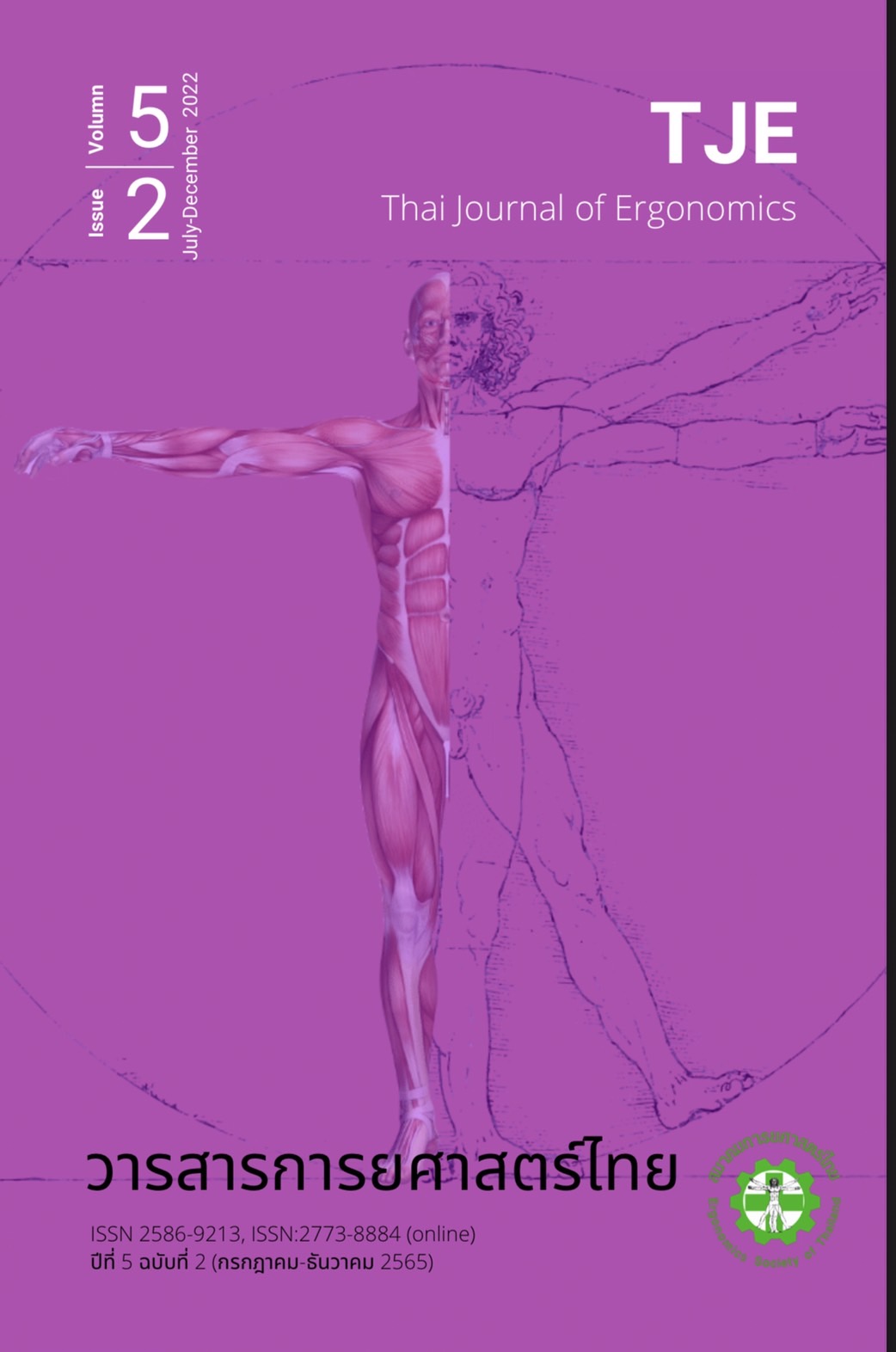Development of mechanical lateral transfer device for patient transfer staff in a hospital
Main Article Content
Abstract
Patient transferring task is an activity that poses an ergonomic risk to healthcare workers. Using assistive devices is one way to reduce ergonomic risks. But with limited access to devices and the limited number of devices. Therefore, the researcher aims to develop an assistive device to reduce the ergonomic risks of patient transferring task. This research is a quasi-experimental study. A single sample group study was conducted with purposive sample of 8 healthy volunteers. Two types of tests were performed, manual patient transferring task and patient transferring task by using the assistive devices. Research instruments were questionnaires, ergonomic risk assessment form (REBA) and electromyography. The data will be collected and compared REBA score, muscle contraction force and the length of time in lateral transfer task between the manual patient transfer and the assistive devices by using Wilcoxon signed-rank test statistics. All of the participants in this research passed the inclusion and exclusion criteria. Participants were all male, average age 40.88 years, average weight 71 kg and average height 168.75 cm. The results showed that the REBA score while using mechanical lateral transfer device was 3.88 that significantly was lower than manual patient transferring (P < 0.001). The maximum voluntary contraction value (%MVC) of the Latissimus dorsi muscle and the Iliocostalis muscle while using mechanical lateral transfer device were 19.84% and 28.46%, respectively. The values were significantly lower than that of the manual patient transferring with the maximum voluntary contraction value (%MVC) of the Latissimus dorsi muscle and the Iliocostalis muscle were 32.46% and 34.46%, respectively (P < 0.01). The average time for manual patient transferring was 29 seconds, which was significantly shorter than using the mechanical lateral transfer device (79 seconds, P< 0.001). This research suggests that using the mechanical lateral transfer device can reduce the ergonomic risks of patient transfer staff, including inappropriate posture and back muscle contraction force.
Article Details

This work is licensed under a Creative Commons Attribution-NonCommercial-NoDerivatives 4.0 International License.
References
Hartvigsen J, Hancock MJ, Kongsted A, Louw Q, Ferreira ML, Genevay S, et al. What low back pain is and why we need to pay attention. Lancet. 2018;391(10137):2356-67.
กองโรคจากการประกอบอาชีพและสิ่งแวดล้อม. รายงานสถานการณ์โรคและภัยสุขภาพจากการประกอบอาชีพและสิ่งแวดล้อมปี 2561. [อินเทอร์เน็ต]. นนทบุรี: กองโรคจากการประกอบอาชีพและสิ่งแวดล้อม กรมควบคุมโรค; 2561 [เข้าถึงเมื่อ 7 สิงหาคม 2565]. เข้าถึงได้จาก: http://envocc.ddc.moph.go.th/uploads/situation2/2561/2561_01_envocc_situation.pdf
เฉลิมรัฐ มีอยู่เต็ม. การศึกษาความชุกและปัจจัยที่เกี่ยวข้องกับอาการปวดหลังส่วนล่างของบุคลากรทางการ พยาบาลในโรงพยาบาลนครปฐม. วารสารแพทย์ เขต 4-5. 2020;39(4):578-90.
Knibbe HJ, Knibbe NE, Klaassen AJ. Safe patient handling program in critical care using peer leaders: lessons learned in the Netherlands. Crit Care Nurs Clin North Am. 2007;19(2):205-11.
Blay N, Roche MA, Duffield C, Gallagher R. Intrahospital transfers and the impact on nursing workload. J Clin Nurs. 2017;26(23-24):4822-9.
Marras W, Davis K, Kirking B, Bertsche P. A comprehensive analysis of low-back disorder risk and spinal loading during the transferring and repositioning of patients using different techniques. Ergonomics. 1999;42(7):904-26.
Smedley J, Egger P, Cooper C, Coggon D. Manual handling activities and risk of low back pain in nurses. Occup Environ Med. 1995;52(3):160-3.
Schaafsma FG, Anema JR, van der Beek AJ. Back pain: Prevention and management in the workplace. Best Pract Res Clin Rheumatol. 2015;29(3):483-94.
Pellino TA, Owen B, Knapp L, Noack J. The evaluation of mechanical devices for lateral transfers on perceived exertion and patient comfort. Orthop Nurs. 2006;25(1):4-10.
Noble NL, Sweeney NL. Barriers to the use of assistive devices in patient handling. Workplace Health Saf. 2018;66(1):41-8.
Faul F, Erdfelder E, Lang A-G, Buchner A. G* Power 3: A flexible statistical power analysis program for the social, behavioral, and biomedical sciences. Behav Res Methods. 2007;39(2):175-91.
Jin S. Biomechanical characteristics in the recovery phase after low back fatigue in passive and active tissues. Int J Ind Ergon. 2018;64:163-9.
Higgnet S, Mcatamney L. Technical Note, Rapid Entire Body Assessment. Appl Ergon. 2000;31(2):201-5.
Vinstrup J, Jakobsen MD, Madeleine P, Andersen LL. Biomechanical load during patient transfer with assistive devices: cross-sectional study. Ergonomics. 2020;63(9):1164-74.
Bergman R, De Jesus O. Patient Care Transfer Techniques. StatPearls [Internet]. 2020.[cited 2022 Aug 07]. Available from: https://www.ncbi.nlm.nih.gov/books/NBK564305/
Salmani Nodooshan H, Choobineh A, Razeghi M, Shahnazar Nezhad Khales T. Designing, prototype making and evaluating a mechanical aid device for patient transfer between bed and stretcher. Int J Occup Saf Ergon. 2017;23(4):491-500.
Miller A, Engst C, Tate RB, Yassi A. Evaluation of the effectiveness of portable ceiling lifts in a new long-term care facility. Appl Ergon. 2006;37(3):377-85.
Edlich R, Winters KL, Hudson MA, Britt L, Long III WB. Prevention of disabling back injuries in nurses by the use of mechanical patient lift systems. J Long-Term Eff Med Implants. 2004;14(6):521-33.
Garg A, Owen B, Beller D, Banaag J. A biomechanical and ergonomic evaluation of patient transferring tasks: bed to wheelchair and wheelchair to bed. Ergonomics. 1991;34(3):289-312.
Holtermann A, Clausen T, Jorgensen MB, Aust B, Mortensen OS, Burdorf A, et al. Does rare use of assistive devices during patient handling increase the risk of low back pain? A prospective cohort study among female healthcare workers. Int Arch Occup Environ Health. 2015;88(3):335-42.
Waters TR. When is it safe to manually lift a patient? Am J Nurs. 2007;107(8):53-8.


